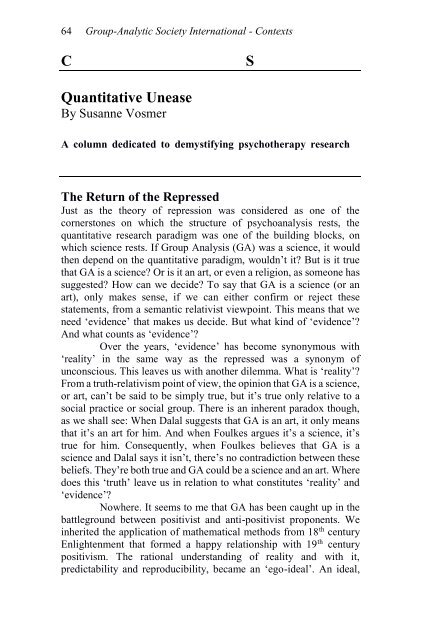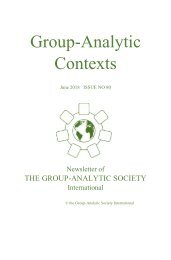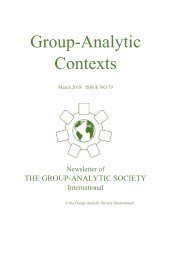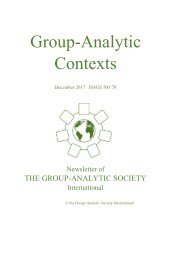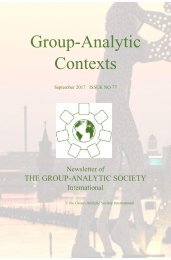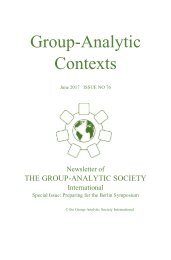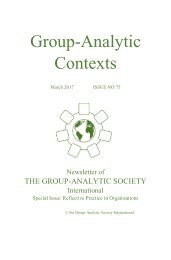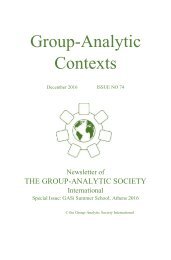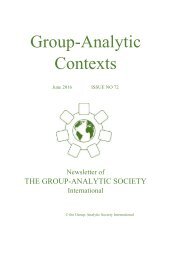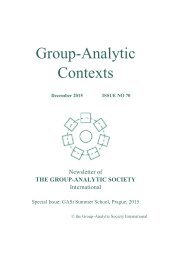Group-Analytic Contexts, Issue 81, September 2018
Newsletter of the Group Analytic Society International
Newsletter of the Group Analytic Society International
Create successful ePaper yourself
Turn your PDF publications into a flip-book with our unique Google optimized e-Paper software.
64 <strong>Group</strong>-<strong>Analytic</strong> Society International - <strong>Contexts</strong><br />
C 2 1 7 ( ; 7 6 & 2 / 8 0 1 , 6 7<br />
S<br />
Quantitative Unease<br />
By Susanne Vosmer<br />
A column dedicated to demystifying psychotherapy research –<br />
O R Y H L W K D W H L W R U E R W K « D W O H D V W W U \ W R N Q R Z Z K D W L W V D O O D E R X W <br />
The Return of the Repressed<br />
Just as the theory of repression was considered as one of the<br />
cornerstones on which the structure of psychoanalysis rests, the<br />
quantitative research paradigm was one of the building blocks, on<br />
which science rests. If <strong>Group</strong> Analysis (GA) was a science, it would<br />
then depend on the quantitative paradigm, wouldn’t it? But is it true<br />
that GA is a science? Or is it an art, or even a religion, as someone has<br />
suggested? How can we decide? To say that GA is a science (or an<br />
art), only makes sense, if we can either confirm or reject these<br />
statements, from a semantic relativist viewpoint. This means that we<br />
need ‘evidence’ that makes us decide. But what kind of ‘evidence’?<br />
And what counts as ‘evidence’?<br />
Over the years, ‘evidence’ has become synonymous with<br />
‘reality’ in the same way as the repressed was a synonym of<br />
unconscious. This leaves us with another dilemma. What is ‘reality’?<br />
From a truth-relativism point of view, the opinion that GA is a science,<br />
or art, can’t be said to be simply true, but it’s true only relative to a<br />
social practice or social group. There is an inherent paradox though,<br />
as we shall see: When Dalal suggests that GA is an art, it only means<br />
that it’s an art for him. And when Foulkes argues it’s a science, it’s<br />
true for him. Consequently, when Foulkes believes that GA is a<br />
science and Dalal says it isn’t, there’s no contradiction between these<br />
beliefs. They’re both true and GA could be a science and an art. Where<br />
does this ‘truth’ leave us in relation to what constitutes ‘reality’ and<br />
‘evidence’?<br />
Nowhere. It seems to me that GA has been caught up in the<br />
battleground between positivist and anti-positivist proponents. We<br />
inherited the application of mathematical methods from 18 th century<br />
Enlightenment that formed a happy relationship with 19 th century<br />
positivism. The rational understanding of reality and with it,<br />
predictability and reproducibility, became an ‘ego-ideal’. An ideal,


